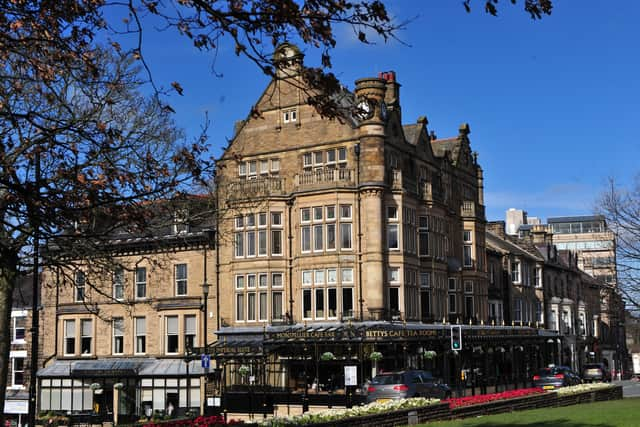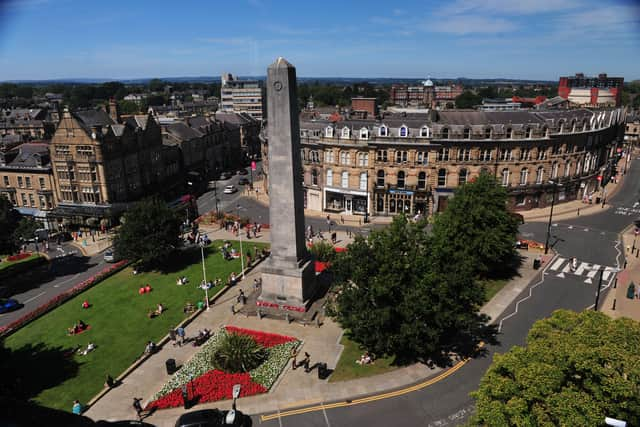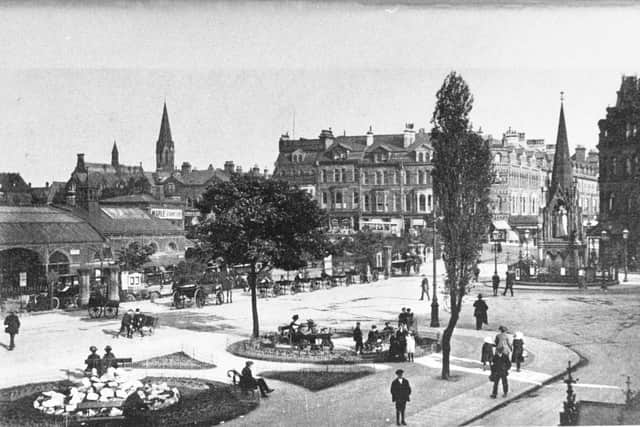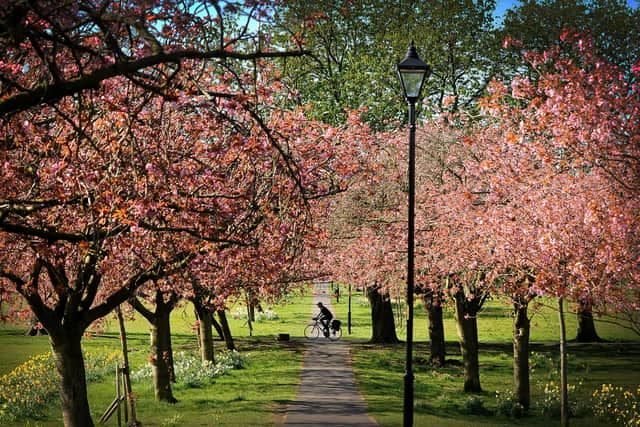Testing the water - and the restaurants, bars, cafes and shops - in the happy town of Harrogate
Is Harrogate posh? Try popping the town’s name into a popular online search engine and you will find this is one of the top questions asked, closely followed by “Is Harrogate worth visiting?”, “Is Harrogate wealthy?” and “Is Harrogate expensive?” And the answers to these searching questions? Well, there is a lot of money in Harrogate; a short wander around its green and pleasant Porsche-lined boulevards will confirm that. Money comes into the town, too. Before the pandemic, coachloads of shoppers would arrive, seeking out James Street for Jigsaw, Whistles, Mint Velvet, LK Bennett, Space NK and Jo Malone. On West Park, there is Oka, the interiors store founded by Samantha Cameron’s mother, Annabel Astor. In 2017 The Ivy opened its first Yorkshire restaurant there, cannily close to Bettys, where Fat Rascal seekers queue outside its famous windows.
There are some mind-blowing houses in Harrogate. Take a walk down Ripon Road to the Duchy estate to see some fine and fascinating villas that would not look out of place on Cap Ferrat. The Duchy is a conservation area owned by the Duchy of Lancaster (the Queen), developed in the late-19th and early-20th centuries, when it became home to the seriously monied. Sir Montague Burton moved in 1918 to Kent Road (he is buried in Stonefall Cemetery). On Cornwall Road is Pineheath, a quirkily handsome mansion that was the home of Indian shipping magnate Sir Dhunjibhoy Bomanji, a philanthropist knighted after using his wealth to support Britain’s First World War effort. His wife, Lady Frainey Bomanji, a great patron of the arts in Harrogate, died in 1986 and Pineheath now appears in a state of some disrepair, sad considering its historical interest, a glimpse into the social whirl of Harrogate past.
Advertisement
Hide AdAdvertisement
Hide AdOther notable buildings include the Grade II-listed Grove House on Skipton Road. In 1882 it became the home of inventor Samson Fox, who refined the production of water gas in his basement laboratory, the first house in the world to be lit in this way. His descendants include the actor Edward Fox and his daughter, Silent Witness actor Emilia Fox.


Today, there must be something in the water in Harrogate that accounts for the exceptionally contented nature of its townsfolk, as it regularly scores highly as one of Britain’s happiest places to live – and for three consecutive years (2013–2015), scooped top place.
It has always been a happy place, it seems. Charles Dickens described it as “the queerest place with the strangest people in it, leading the oddest lives of dancing, newspaper reading and dining”. Given Harrogate’s long-standing reputation for gentility and decorum, his observations are surprising but he did put his finger on something of the essence, the oddity, of the town and its curious mix of relaxation and bustle.
Harrogate’s centre, radiating from the Cenotaph, is a hub for local residents, surrounding rural communities and for business visitors and tourists. But this hub is wrapped about by the Stray, 200 acres of open parkland, giving the town a distinctive, airy, leisurely atmosphere. Here, town meets country as outdoor sports and walking blend into working, bar-hopping, dining and shopping.
Advertisement
Hide AdAdvertisement
Hide AdThe very existence of Harrogate is an oddity. No river runs through it. Compared with its much older neighbours of Knaresborough, Ripon and Wetherby, Harrogate is a relative newcomer. It began life as two villages, High and Low Harrogate. Then came the discovery of that something in the water, the reason for its motto Arx Celebris Fontibus, “a citadel famous for its springs”.


William Slingsby is credited with discovering the first spring in 1571. He named it Tewit Well, after the local word for the lapwing and, having been on a Grand Tour, decided the water was like that of Spa in Belgium. More medicinal springs were discovered and the land between the two villages came to be deemed common property, with everyone allowed access and animals able to roam or stray there. The Stray has been preserved by acts of Parliament ever since; nothing can encroach on its flat grass parkland. It continues to be well used, for walking, picnicking, sports, exercise and personal training and major outdoor events. True, some locals took exception to the churning that occurred during the rain-battered 2019 UCI cycling championships, but the ground now seems well recovered.
Throughout the Georgian and Victorian eras, Harrogate became a fashionable spa resort. The Royal Pump Room was built in 1842 over the Old Sulphur Well and its pre-existing cover transferred to Tewit Well. In 1887 the Valley Gardens were newly laid and a decade later the Royal Baths opened. The Turkish Baths there are still operating, offering a window into former spa glories.
Today, Harrogate cafe-bar and dining society is (or will be) alive and well, with cool independents adding to the vibrant mix, including Hoxton North, Baltzersens, Major Tom’s at Space Vintage and 53 Bo Grove cafe and antiques emporium (which has branches on Grove Road and in the centre on Oxford Street. Look out too for West Park Antiques and, close by, Weetons food hall and cafe.
Advertisement
Hide AdAdvertisement
Hide AdThere are lively off-town centre pockets with a bohemian feel. Head to King’s Road for delis, takeaways and quality florists and fruit and veg (Regal Fruiterers) and to Cold Bath Road for La Feria restaurant, the Fat Badger, great indie shops, cafes and Oliver’s legendary fish and chips.


The Everyman cinema on Station Parade offers a luxurious way to enjoy the latest film releases from the comfort of its sofas, and its large bar and dining area is contemporary and cool, with excellent music and an outdoor terrace, so a popular place for meetings, whether social or business.
Thanks to its spa legacy of a plentiful supply of entertainment venues and hotels, Harrogate is still a centre for cultural, retail and trade events. There is, of course, the Great Yorkshire Show, planned to go ahead in July. Harrogate International Festivals organises several prestigious annual events, bringing world-class performers and tourism to the town, including the Theakston’s Old Peculier Crime Writing Festival which hopefully will take place in late July. It is hoped, too, that in November the popular pre-Christmas market will return to the lower Stray and the Country Living Christmas Fair to the Harrogate Convention Centre.
As a film location, Harrogate can be glimpsed in Chariots of Fire and the Bilton Woods viaduct was used for Paddington 2. The 1979 film Agatha - based on Christie’s disappearance in 1926 - has some fascinating exterior shots of the town.


Advertisement
Hide AdAdvertisement
Hide AdSo well worth visiting, but what is it like to live in Harrogate? As a resident for almost 25 years, at first I did find it a little posh, wealthy and expensive. It might have a reputation among some for being full of inward-looking traditionalists but in the 2016 referendum Harrogate was one of only three places in Yorkshire where the majority voted to stay in the EU. It is slowly becoming more multicultural and estate agents report that its schools, housing and open spaces make it popular for families relocating from London and elsewhere.
Step into the Harrogate groove and you might soon find that every day has something of the weekend about it. You cannot get away from the Stray, but then why would you want to? From March onwards, it dances with crocuses in purple, yellow and white, and then, at some point in April or May, the long cherry tree walkways turn coral pink with their heavenly frothy blossoms – surely one of the seven wonders of Yorkshire.
Comment Guidelines
National World encourages reader discussion on our stories. User feedback, insights and back-and-forth exchanges add a rich layer of context to reporting. Please review our Community Guidelines before commenting.